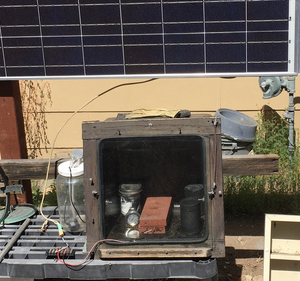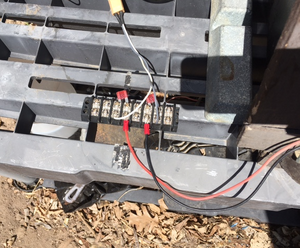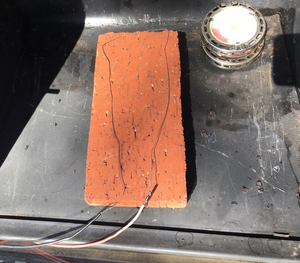|
Last edited: 1 November 2023
|
Craig Bergland is a solar inventor living in northern Nevada, USA. Besides creating new, Craig has developed some interesting adaptations and techniques for existing solar appliances. He chronicles his activities on his facebook page at: Secret Solar Institute of Northern Nevada.
He was visited by Luther Krueger in the fall of 2020, and Luther videoed Craig as he explained his various projects. In particular, he demonstrated how he created a coffee bean roasting station combining a parabolic solar reflector with a solar charged battery driven roasting bin. The video can be seen at: Craig Bergland: The Found Art of Solar Energy
News[]
- November 2023: New pyramidal reflector - Craig Bergland has fashioned a new reflector from sheetmetal that he describes having a secondary use as a 'tin hat'. Good for a cuppa rice.
-
- Photo credit: Craig Bergland
-

Nichrome wire heating element placed between two bricks, Photo credit: Craig Bergland

Electrical connections, Photo credit: Craig Bergland

The Nichrome heating element, Photo credit: Craig Bergland
- April 2021: Using nichrome wire as an assist to solar cooking, and as stand-alone cooker with (PV charged) batteries
- Here are initial results using a 17 inch (430mM) piece of nichrome with a 120W 12V PV panel. The wire was placed between two thin bricks in an AASO sun oven, next to another AASO without the wire. The first test was temperature difference, and the wired oven was plugged directly into the PV panel. Over several weeks, the wire consistently raised the oven daily from between 80 to 100°F compared with the standard oven. Max readings were a bit over 425°F (218C).
- The wire can run on many different voltages, and thus can be used to generate different temperatures. Also the length of wire is a determinant - shorter wire gets hotter, longer does not. Here are some quick readings on using just battery power:
- 4V lithium battery 132°F (56C). 5W power used.
- 8V lithium battery 230°F(110C). 20W.
- 13.4V (direct PV) 337°F (169C). 63Watts.
- Nichrome can apparently handle temperatures in excess of 1,000 C according to specs.
- The wire is nice because it is a fairly inexpensive system, and parts available through EBay, etc. Here is a breakdown of costs for the setup bought in bulk. 17” of nichrome wire $0.11
- Two non-insulated crimp connectors $0.28. You cannot solder the wire, solder will melt, you must use physical crimp or other mechanical method. 5 feet high-temp silicone wire, to keep from melting its insulation in your cooker is USD$1, Misc. connectors and fuse (good idea) are estimated to be USD$2 to $10. Total minimal cost under USD$4, assuming you have a PV panel.
- While this works well as an assist while the sun shines, using batteries to cook is going to be much more expensive. Certainly a car battery can work, but for how long a use it is unknown. Input on this is welcomed. Pete Schwartz, Seggy Segaran and others are the go-to sources for info on this stuff. Since one of my hobbies is playing with lithium batteries, here are some thoughts. (Note, lead acid batteries are cheaper, and have generally larger capacity, but cannot be discharged as low as lithiums, and it is believed do not have as many cycles available. Again this is a matter of cost and availability).
- Here is a theoretical scenario using a 40V 185W lithium pack for achieving different temperatures. I do not ever discharge the batteries to full potential in order to lengthen their life cycles. So let’s assume we will use only 100W of this 185W before recharging. With a buck inverter (EBay, etc.), many lower voltages can be configured. Running at 4V, the setup ‘should’ allow for temperature of 132F for 20 hrs. At 8V that ‘should’ be 230F for 5 hours. And at 12.8V that is 326F for about 1 hr and 40 some minutes. This needs verification, otherwise i am just blowing smoke, however i am now testing a single NCR18650A lithium, rated at 2900mAhrs on the above wire. Here are results starting at 4.2V charge— (11.6W total capacity, I will discharge to 3V. This battery is rated down to 2.5 V but I don’t like to take them that low.) Test was stopped at 2 and 1/2 hrs. Used 6.9W to keep at 120°F. Battery end voltage 3.18. Yes, a single lithium may keep my coffee cup warm for a few hours.
Results[]
- You will not be able to cook a steak with a single lithium cell, but with a few of them in series, it’s probably good to go.
- In sous vide cooking it is for sure a possibility with this, and temperature could be regulated by either changing the voltage, or changing the length of wire.
- The wire i used here was just over 20 inches, so as a result the temp only got up to 120F. (Shorter wire would be hotter at the risk of repeating myself, sorry). Of course, to cook exclusively on battery power will require a Well-Insulated cooking box to minimize heat loss.
- The more insulation, the better the result. Also note that at lower voltages, your heat box can be used as a food warmer, and with a step down (buck) converter, most any temperature settings could be had.
Conclusions[]
- Nichrome using direct PV, may allow your box oven to reach good bread making range - 425F.
- (Solar charged) Batteries can power wire for cooking, dependent on size of your battery bank.
- Temperatures can be regulated leading to sous vide and other cooking techniques, possibly even high voltage high temp Wok cooking at the other end of the spectrum.
- Reasonably priced, a good build it yourself project.
- Nichrome could be used for other purposes, such as soldering, starting fires, smokes or charcoal, melting small batches of low temp metals, heating percolating refrigerator elements, small batch hot water or steam, electric blankets, vests, comforters, burning incense, branding(???), keeping wine, bread or yeast products at optimum temperatures, cauterising, cutting foam and plastics, cutting glass jars, and etc. But then, all aside, the very most efficient practice is to cook your meals in your solar oven while the sun shineth...
Audio and video[]
- January 2021:
Craig Bergland- The Found Art of Solar Energy
See water distillation technique at 21:10
See also[]
External links[]
- https://www.facebook.com/Secret-Solar-Institute-of-Northern-Nevada-484726374958393/?ref=page_internal
- https://www.secretsolarinstitute.com
Contact[]
Craig Bergland
Email: cobergland@gmail.com



